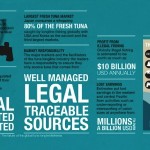
The western and central Pacific Ocean is the world’s largest tuna fishery, with millions of people depending on it for food and their livelihoods. It is also an economic lifeline for many of the region’s small island states.
Tuna are among the world’s most popular fish and among the most commercially valuable. But because of high demand for this fish, many stocks are overfished, the World Wildlife Federation says.
But more and more boats are entering the fishery from developed nations eager to profit from this $7 billion per year fishery. Pacific tuna stocks, in particular albacore, bigeye and yellowfin tuna, are at record low levels.
This graphic from Greenpeace explains how tuna gets from the ocean to your plate and the problems the current fishing system is creating. Click on the image to view a larger version.

The root cause of the record low level of tuna stocks is too many boats with improved tuna plundering technology and efficiency. Close to half of bigeye tuna caught in the region every year is taken by purse seine vessels that use dragnets to catch fish. The vessels are supposed to be targeting the more resilient skipjack tuna. But in the process they also catch bigeye tuna that haven’t had a chance to reach adulthood and reproduce.
More than 3,600 longline vessels are registered to fish in the Pacific under scant regulation, often transshipping their catches at sea, resulting in prolific illegal, unregulated and unreported fishing in the region. Compounding the impact of out-of-control longline fishing is the use of destructive fish aggregation devices or purse seine fisheries.
Greenpeace says the fishery cannot continue to sustain the current system and that further controls on fishing fleets need to be urgently adopted by the Western & Central Pacific Fisheries Commission, which is meeting in Australia this week.
Greenpeace has provided clear steps on how Pacific Island countries can transform their tuna to ensure that fishing is more sustainable and socially responsible so the benefits of this multi-billion-dollar industry flow back to the Pacific and benefit small communities. Greenpeace also provided guidance on how the commission can ensure ocean-friendly fishing in the region through an appropriate selection criterion for vessels that would ensure fewer boats and more fish and more socially appropriate fishing vessels.
This video from Greenpeace explains the challenges surrounding tuna fishing in the Pacific region.
Visit EcoWatch’s BIODIVERSITY page for more related news on this topic.


Leave a Reply
You must be logged in to post a comment.